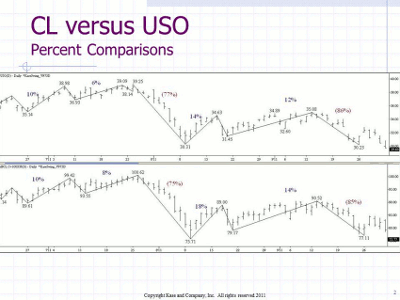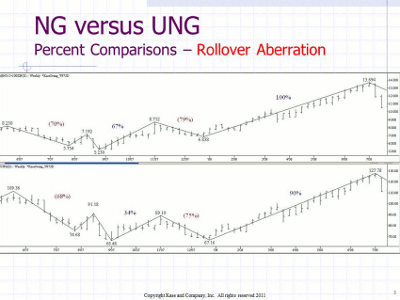Energy ETFs have become notorious for the rollover issues that lead to these ETFs not always tracking the energy futures very closely. Cynthia Kase discusses this phenomenon.
When trading energy, you have a lot of different choices. The biggest two are probably ETFs and energy futures, but there are some things you need to be aware of before you start trading either one.
Our guest today is Cynthia Kase to talk about that. So, Ms. Kase, talk about the kinds of issues that you need to be aware of when you’re trading energy futures versus energy ETFs.
Well, the big question is how do ETFs track futures? They’re designed to track futures on a percentage basis. However, there are what we call rollover issues, and that’s because the ETFs, even though when they’re traded, they’re traded on a continuous basis and they don’t expire, the firms that are managing the ETFs are actually using the energy futures to simulate the ETF.
As each futures contract expires, they have to roll over to the next contract. I used to wonder before I looked into ETFs why they didn’t do a better job on rolling them. What I found out is that by law with the CFTC, SEC, etc., they have to submit the method by which they’re going to roll over, and therefore, they have little to no flexibility in looking at the forward curve and dealing with the forward curve in such a way as to minimize rollover issues.
So it’s kind of a good thing that the investor knows how they’re going to roll over ahead of time. That’s defined, but it’s also a negative thing in that they have no flexibility to avoid some of the rollover issues that are involved with markets where it could be backwarded—the front of the market is higher than the back—or in contango, the front of the market is lower than the back.
You have some images that kind of highlight this as well?
We do. Just briefly let me also mention they have problems with splits and inverse splits. There have been times when the regulators have made the ETFs split or consolidate into a reverse split, which can also cost some aberrant fluctuations in the pricing data.
Here is a comparison of crude oil versus the United States Oil Fund (USO).
In this one, if you look at what I’ve put together here, you can see it correlates pretty well. There’s a 10% increase in the beginning, then 6% versus 8%, 77% versus 75%. So if you look at this chart, it looks pretty good.
Now we’re going to look at nat gas versus the United States Natural Gas Fund (UNG), and nat gas has more extreme rollover issues because it’s more of a seasonal commodity.
NEXT: Rollover Issues in Popular Natural Gas ETF
|pagebreak|Crude oil has driving season with gasoline, and heating season with heating oil, but the seasonality in crude isn’t quite as severe. With nat gas, you can see severe rollover issues when you roll from spring to fall, or fall to spring, etc.
So if you look on this chart here, you look at the nat gas at the top, during the fall of 2007 you can see a rise of 67%; whereas the bottom chart only has a rise of 34%, and that’s most likely due to the rollover problem.
Finally, the UNG had a reverse split in the spring of 2011. Looking at the chart comparing the percent changes, they look about the same until you get to the beginning of 2011.
For the rise from October 2010 to the high in July, there was only a 21% increase; whereas for the regular futures contract, there was a 55% increase. So that’s quite a big difference, plus the high in July was a higher high for the NG futures contract, and it was a slightly lower high for UNG.
So in these seasonal times, does that mean maybe I should shorten my holding period for the ETFs to avoid having this discrepancy?
Yes, for natural gas especially, trading very short term is the key to overcoming or avoiding these problems. For the short-term trader who wants to trade small volumes, the ETFs will work, but for trading longer term, these rollover aberrations and split and reverse-split aberrations can become problematic.
Related Reading:
























